
The demographic characteristics of the population of Croatia are known through censuses, normally conducted in ten-year intervals and analysed by various statistical bureaus since the 1850s. The Croatian Bureau of Statistics has performed this task since the 1990s. The latest census in Croatia was performed in autumn of 2021. According to final results published on 22 September 2022 the permanent population of Croatia at the 2021 census had reached 3.87 million. The population density is 68.7 inhabitants per square kilometre, and the overall life expectancy in Croatia at birth was 78,2 years in 2018. The population rose steadily from 2.1 million in 1857 until 1991, when it peaked at 4.7 million. Since 1991, Croatia's death rate has continuously exceeded its birth rate; the natural growth rate of the population is negative. Croatia is in the fourth stage of the demographic transition. In terms of age structure, the population is dominated by the 15 to 64 year‑old segment. The median age of the population is 43.4, and the gender ratio of the total population is 0.93 males per 1 female.

The economy of Croatia is a high-income service based social market economy with the tertiary sector accounting for 70% of total gross domestic product (GDP). Croatia joined the World Trade Organization in 2000, NATO in 2009, has been a member of the European Union since 1 July 2013 and joined the Eurozone and the Schengen Area on 1 January 2023. Croatia is also negotiating membership of OECD organization, which it hopes to join in coming years.

The kuna was the currency of Croatia from 30 May 1994 until 31 December 2022. It was replaced by the euro on 1 January 2023. It was subdivided into 100 lipa. The kuna was issued by the Croatian National Bank and the coins were minted by the Croatian Mint.

The A1 motorway is the longest motorway in Croatia, spanning 476.3 kilometers (296.0 mi). As it connects the nation's capital Zagreb to the second largest city Split, the motorway represents a major north–south transportation corridor in Croatia and a significant part of the Adriatic–Ionian motorway. Apart from Zagreb and Split, the A1 motorway runs near a number of major Croatian cities, provides access to several national parks or nature parks, world heritage sites, and numerous resorts, especially along the Adriatic Coast. National significance of the motorway is reflected through its positive economic impact on the cities and towns it connects as well as its importance to tourism in Croatia.
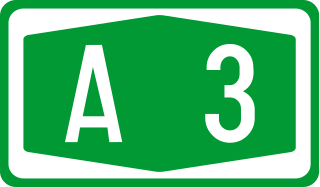
The A3 motorway is a major motorway in Croatia spanning 306.5 kilometres (190.5 mi). The motorway connects Zagreb, the nation's capital, to the Slavonia region and a number of cities along the Sava River. It represents a major east–west transportation corridor in Croatia and a significant part of the Pan-European Corridor X, serving as a transit route between the European Union states and the Balkans. Apart from Zagreb, where the A3 motorway comprises a considerable part of the Zagreb bypass, the motorway runs near a number of significant Croatian cities.

The A2 motorway is a motorway in the Hrvatsko Zagorje region of northern Croatia, connecting Zagreb to the Macelj border crossing and Slovenia. The A2 motorway is part of the European route E59 and the Pan-European Corridor Xa. The motorway spans 59.2 kilometres (36.8 mi) between the Slovenian border and the Jankomir interchange within the Zagreb bypass, providing road connections to a number of cities and towns besides Zagreb, including Krapina, Zabok and Zaprešić. All sections of the motorway, except the northernmost one between the Macelj border crossing and Trakošćan, and the southernmost one near Zagreb, are tolled, using a closed toll collection system.

The A7 motorway is a 42.4-kilometre-long (26.3 mi) motorway in Croatia. It connects the nation's largest port in Rijeka, to the Croatian motorway network, as well as to the Rupa and Pasjak border crossings to Slovenia. The motorway forms part of a longitudinal transportation corridor in Croatia, and it is a part of European route E61 Villach–Ljubljana–Trieste–Rijeka. The A7 motorway route south of Orehovica interchange, where it also intersects Pan-European corridor Vb, is a part of European route E65.
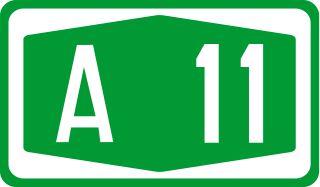
The A11 motorway is an incomplete motorway in Croatia, 30 kilometres long. It connects the Jakuševec interchange of the Zagreb bypass, to the south of Zagreb, to Velika Gorica and onwards to Sisak, but currently reaches only the Lekenik exit, as of the planned 42-kilometre (26 mi) route, 30 km (19 mi) are completed. The motorway is planned as a north–south transportation corridor for commuter traffic between the cities.
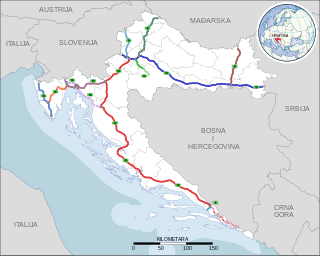
Highways in Croatia are the main transport network in Croatia. The Croatian classification includes several classes of highways:
The D12 is a partially built state road in central Croatia that is intended to connect the Vrbovec 2 interchange with Bjelovar, Virovitica and end at the border crossing Terezino Polje. Its planned length is 86.5 kilometres (53.7 mi).
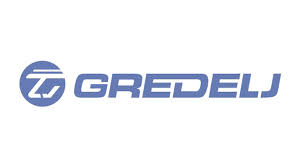
TŽV Gredelj is a state-owned Croatian rolling stock company founded in 1894 as the railway workshops of the Hungarian State Railways.

Energy in Croatia describes energy and electricity production, consumption and import in Croatia.

Croatia osiguranje d.d. is an insurance company based in Zagreb.

D2 state road is a trunk state road in the northern areas of Croatia that spans from the border crossing with Slovenia at Dubrava Križovljanska in the west via Varaždin, Koprivnica, Virovitica, Našice, Osijek, Vukovar, ending at the Ilok–Bačka Palanka Bridge border crossing with Serbia. The road is 347.9 km (216.2 mi) long.

Ledo d.d. is a Croatian-based producer of ice cream and frozen food headquartered in Zagreb.
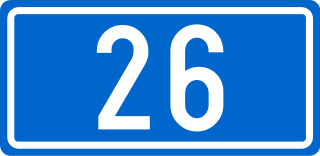
D26 is a state road in central Croatia connecting the D5 in Daruvar and the D10 expressway near Vrbovec, comprising a connection to the planned but cancelled A12 motorway route. The road is 88.5 km (55.0 mi) long.

The D10 expressway is a partially built expressway in the central Croatia northeast from Zagreb extending towards the city of Križevci. It is currently executed as a 35 km (14 mi) long expressway that spans from the A4 motorway Sveta Helena interchange via Vrbovec, to the city of Križevci. The D10 expressway represents the western arm of the so-called Podravina Y, as the eastern arm is planned to be the D12 expressway.

Novi Dvori of Zaprešić, or Novi Dvori of Jelačić, is a feudal estate in the northwestern part of Zaprešić, Croatia. The estate consists of a castle, an old granary renovated into a museum, a circular threshing machine, a neo-gothic chapel and the Jelačić family tomb.

Kandit is a Croatian confectionery company producing chocolate and jelly products which is headquartered in Osijek. The company, together with Zvečevo and Kraš, made up 97% of the confectionery industry in 2020 Croatia. Exports make up 47% of Kandit's revenue. The company was acquired by Mepas of Bosnia and Herzegovina in 2011 for 6 million euros.
The Croatian euro coins are a set of euro coins currently being minted by the Croatian Mint since July 2022. They are the official euro coins with the national motif of Croatia.


















